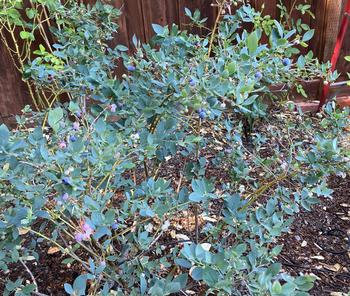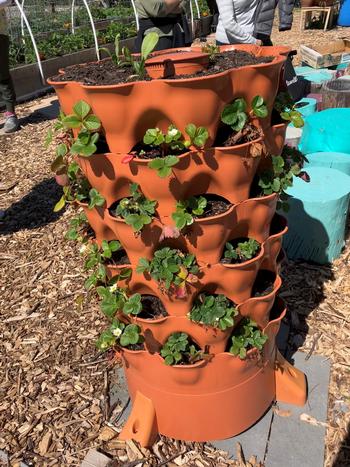Bountiful berries
-
Sara O’Keefe
-
How about some blueberry muffins, raspberry scones, or strawberry shortcakes? They can be yours with some work in your garden. There’s nothing like an edible sun-kissed harvest. Not only are the berries good for humans, but their blossoms provide pollen and nectar for beneficial insects and food for birds and wildlife.
 Some blueberries are ready to pick. Photo: Sara O'Keefe
Some blueberries are ready to pick. Photo: Sara O'KeefeWith blueberries (Vaccinium spp), the first step is to acidify the soil since blues need pH 4.5 – 5.5 and well-draining soil. It can be done by adding peat moss or elemental Sulphur. It may take six months to a year for the soil to be acidified to the needed pH level. Raspberries and blackberries have the same soil requirement. Blueberries sport pink or white flowers in the spring, berries in the summer, and red and yellow foliage in the fall.
Plant them anytime from fall to spring. Choose either bare root or two-to-four-year-old bushes. Dig the hole 1 foot deep by 2 feet wide, spreading the roots shallowly in all directions. The shallow root system needs consistent water along with good drainage and mulch.
Although blueberries are self-pollinating it is better to have two or more varieties that bloom at the same time. In Marin, choose blueberries that have low chill hours between 32 and 45 degrees over the winter. The Southern high bush excels with these varieties: Bountiful Blue, Sunshine Blue, Misty, and Jubilee. The primary pollinators are bumblebees who vibrate the flowers, a behavior called buzz-pollination. Native and honey bees also pollinate. Harvest when the berry is completely blue for the sweetest flavor.
Strawberries (Frangaria spp) are low-growing plants with red heart-shaped berries. There are two types of plants: Day Neutral/everbearing and Short Day. Day Neutral produces berries from April through October, while Short Day delivers one crop of a better quality in late spring. Day Neutral may be planted in fall or early spring for spring through fall production. If Short Day berries are planted in August, there will be a fall and spring-to-summer crop. Strawberry plants are growing in a multilevel planter. Photo: Sara O'Keefe
Strawberry plants are growing in a multilevel planter. Photo: Sara O'KeefeStrawberries favor sandy loam soil and regular water. In a sunny location, set out plants 12 inches apart in beds or plant them in containers or planter boxes that are 12 inches deep. Soil should be between pH 5.0 and 7.0 and can be amended with compost and leaf mold weeks before planting. Plant 4 to 6 inches deep, fan out the roots, and add a 5-10-10 fertilizer. Plants will thrive with a light application of fish emulsion every 4 weeks. Mulch and replace plants after 2 or 3 years.
The best varieties for Marin are Day neutral/everbearing—Seascape, Albion, Tri-Star—and for Short Day, Aromas, Chandler, and Sequoia.
Raspberries (Rubus spp.) have perennial roots and biennial canes that fruit in the second year and become productive in the third year. Like blueberries, they need acidic soil, water, and mulch.
Plant with one inch of soil over the crown and cut back to about two inches so new canes will form roots. Plant raspberries two to three feet apart along a trellis or fence for support. During the year, raspberries need nitrogen, which can be from organic sources such as blood meal, fish meal, or compost.
There are two types of Raspberries: fall-bearing, which may produce berries in fall and spring, and Summer-bearing, which produces berries only in summer. When grown in full sun, raspberries are adapted to cool coastal climates. Most ripen in 40- 60 days from bloom.
A small, thornless variety, Raspberry Shortcake, 2.5 to 3 ft., may be grown in a container. For all varieties, cut back spent canes to the ground after harvesting.
In Marin, fall cultivars that tolerate summer heat are Autumn Bliss, Bababerry, and Oregon 1030. Summer-bearing are Chilliwack, Nootka, and Sumner.
Some other delicious berries to consider are blackberries, boysenberries, tayberries, or olallieberries. Happy harvesting! For more details on growing berries, go to: https://cagardenweb.ucanr.edu/Berries/


